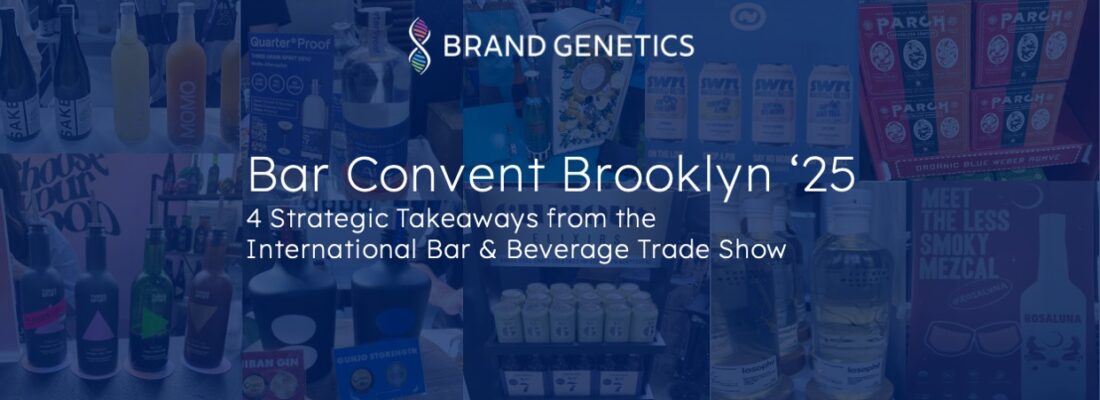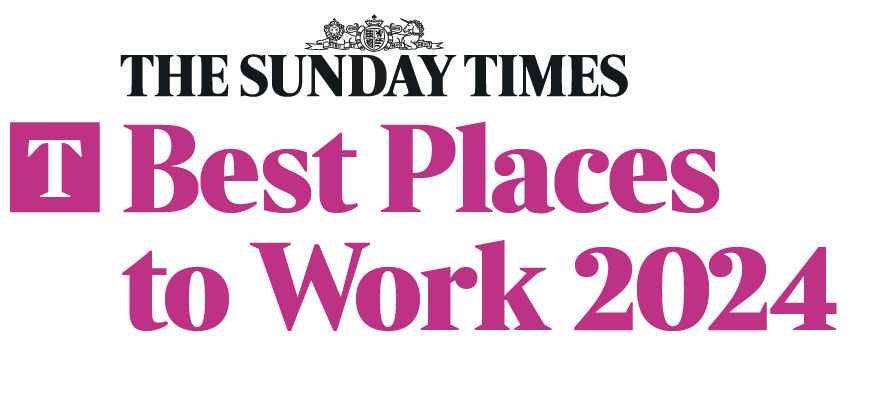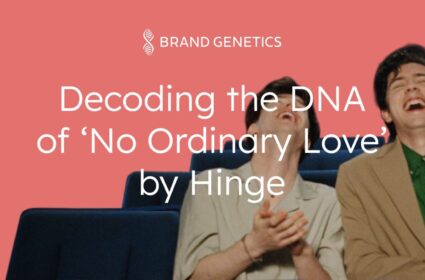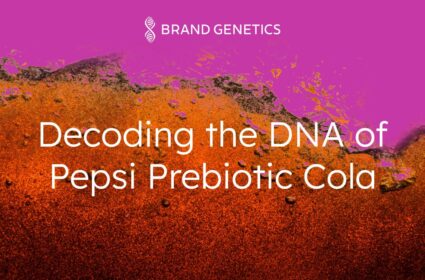Bar Convent Brooklyn ’25: 4 Strategic Takeaways from the International Bar & Beverage Trade Show

We came, we saw, we sipped. While BCB London (previously Imbibe) has been a staple for Brand Genetics for many years, this year we headed to the cocktail capital of the world to get to the cutting edge!
Long story short, you will have heard musings on an alcohol industry in decline, but what we found was a period of evolution and adaptation. A global representation of spirit brands, non-alcoholic alternatives, mixer beverages and bar staff made it out to Industry City in the warming Brooklyn June weather, and the lively atmosphere was just short of being its own party – the future is bright!
Here are 4 key takeaways we learned from our trip to Bar Convent Brooklyn 2025.
Furthering Flavor Horizons
The most striking takeaway from the day was just how expansive flavor has become.
On both demand (increasing consumer interest/ openness) and supply side (thank you Cannabis for catalyzing flavor extraction innovation) the door has been kicked wide open!
Non-alcoholic brands like Curious Elixirs and Three Spirit are leading the charge with complex flavor profiles meant to satisfy those sitting out a round of cocktails. These brands have shaken up the sector by offering intricate flavor experiences that are decoupled from anchoring themselves in an alcoholic counterpart.
Expect less anchoring in the known (e.g. alcohol free XYZ) and more proudly stand-alone flavor profiles!
For example, Three Spirit offers products that ground themselves in moods—their “Livener” range combines watermelon, pomegranate, adaptogenic berries and different types of acidic profiles for a fresh and fiery taste; their “Nightcap,” on the other hand, blends maple syrup, licorice, hot peppers and several root extracts for a warm and calming experience.
In response, the ‘full strength’ counterparts are borrowing some of these techniques to put the booze back into unique flavored beverages – and so the battle for differentiation continues! Offerings like Cambridge Distillery’s Truffle Gin, and Ile Four’s infused sake collection show spirits adding sophisticated twists to their portfolio, while drinks like Bubba’s Pancake & Bacon Flavored Whiskey reminded us that it’s not all Haute Couture – it’s perfectly okay to keep having fun with it.
Alongside variety, we see the functional wave continuing to evolve – with credibility to offer more than ‘empty calories.’
Parch Adaptogenic Agave Non-Alcoholic Cocktails are offering 185mg of their custom Ashwagandha, L-Theanine and American Ginseng blend to “work symbiotically with your body’s natural functions.”
Nebula9 Vodka displayed their apple-cider-vinegar-infused ready-to-drink selections, which your body supposedly absorbs better, making them easier to digest.
What can brands take away?
First and foremost, be brave! New flavors are out there, and the consumer palate is more evolved than ever. If your brand is looking for a spark to its portfolio, now might be the time to hire an alchemist and get cooking on an exciting new flavor.
That said, it is also critical to remain outcome focused. For long term success, the ingredient is the means to a better flavor, not a stand-alone hero as it has been in the past. Ask yourself and your R&D team “what experiences are we trying to create?” Consumers are okay with abstract ideas or product names if the experience is unique and engaging. Rather than adding a ‘Mango’ SKU for the sake it of it why not imagine what a ‘Caribbean Sunset’ tastes like?
Lastly, don’t forget to have fun and be entertaining to your audience. Tasting notes are not new, but BCB reminded us these notes have come a long way from how Wine and Whisky started the trend – get creative with your naming and remember that your flavor is only one part of your brand story. Think less ‘toasted pine’ and more ‘hiking through the forest on the perfect autumn day.’
Gentle Now! The Softer Side of Taste
Another interesting trend, alongside the breadth of new flavors, is a conscious movement down the intensity scale. In a business that used to pride itself on its products having a ‘kick’ or a ‘bite’, a new, softer wave of flavors are hitting the market. In a crowded space, alcohol brands offering a different perspective on their category might be able to break through the noise.
Edinburgh Gin’ Seaside Coastal Dry Gin is said to taste “like a cool crisp breeze over windswept golden sands.” Infused with seaweed botanicals, along with other unique flavors, EG’s Seaside Gin is meant to bring a sweet, yet salty spin to a drink that is often perceived as overwhelming to those that don’t enjoy the traditional Juniper-led variety.
Rosaluna Mezcal takes it a step further — branding itself as “the less smoky Mezcal.” This calling card may be off-putting to traditionalist drinkers of the spirit, but for those that are less enamored by the smoky, spicy flavor of Mezcal, Rosaluna might just be the perfect entry point.
Offerings like these indicate a level of self-awareness amongst modern spirit-producers that the harsher, more intensive side of their liquids aren’t always appreciated and can create a barrier to entry for drinkers who are less familiar with them. Reducing the intensity, and therefore the intimidation factor, is creating a new era of accessibility (and versatility) for the category.
Similarly, looking at the pure strength of certain spirits, BCB ‘25 also displayed a shift towards lower alcohol content. For those looking to reduce their intake or blend an elaborate concoction, without fully foregoing a buzz, brands like Quarter Proof (15% ABV) are ideal.
The trend towards going “low not no” was apparent throughout the conference, with an abundance of liqueur and aperitif brands making an appearance too. The likes of Iosophe Margarita (24% ABV) and Italicus Rosolio di Bergamotto (20% ABV) showed their versatility as delicious stand-alone options or the perfect base for a more complex, low-alc cocktail. To earn a sustainable role in consumers’ lives, stretching across moments which require a range of strengths, is a recipe for success.
What can brands takeaway?
It is okay to be gentler with your mix. While your classic whisky-on-the-rocks drinker will always be present, many consumers are calling for a gentler vision of the spirit industry.
This can be about brand (it’s tough out there, softer semiotics can be a soothing balm), this can be about ABV (versatility in a Zebra-striped world) or this can be about taste intensity.
Winning brands are learning it’s not about being quite so full on!
New Be-Gin-nings
Alcohol in general has taken a beating in the media, but Gin has had it particularly rough. The “gin boom” peaked at $3 Billion in US revenue in 2022, accounting for 30% of the category in 2020.
However, the last two years have brought a new narrative that this boom is over, with US sales specifically dropping
BCB offered a refreshing double click. Brands and producers are taking it as an opportunity to meet consumer demands head on.
Moving past the ‘sugar high’ of novelty flavors (see above point on flavor not being the end goal but being the vehicle) and color (not a pink gin in sight) we are seeing a re-investment in quality core products.
There is a reason gin is in the world’s most popular cocktails, and as the consumer cocktail experience grows, we must grow with it and remind bartenders of all the possibilities that gin offers.
A great example is Alembic Distillery’s Hachiban Gin, a Japanese brand that hangs its hat on a process that creates a subtle, citrus-forward spirit.
What can brands takeaway?
While the gin boom may be over, the revolution is just beginning. When working on new menu items or offerings, remember why gin became so popular to begin with.
Gin is relatively cheap compared to other spirits—and works well in a number of classic & cutting edge cocktails—which is great for bars! Consider how to make the most of a cost-effective liquid that works across several different types of drinks (moving cases means not always being the hero).
A reminder for those less familiar with the American drinking context, be careful with the soda gun – simple classics like the Gin & Tonic can be regularly let down by the bar they are being served in.
From a consumer perspective, try to center the outcome of cocktails rather than the base.
In the words of one bartender: “When we simply put a gin on the menu, people tell us they don’t really like gin – but when we make them a complex cocktail where gin is secretly the main spirit, suddenly they love it!”
So, when the conversation is about flavor profiles, gin shouldn’t be the question, it should be the answer.
Welcome In, The Bar is Open
Outside the distillery, the world is a tough place right now. Financial pressures, a global backdrop of loneliness and political uncertainty. Consumers are seeking community and connection – and winning brands are leaning in to this.
For some, this is about the community you come from. Brands like Campo Azul and Mezcal Guey are digging deeper into their heritage and unlocking tales of small towns, fair trade and community connections.
Owning the nuance of the community and environment you produce in can be key. Glendalough Distillery is a stand-out with their ‘Wild Botanical Irish Gin,’ which uses botanicals foraged in the Irish mountains all year round, meaning each batch of bottles taste slightly different. Not a flaw, a benefit.
For others, this is about investing in the community you are entering or creating. Winning bars are needing to dig deeper to solidify their ‘third space’ status and creativity is crucial.
From Sycamore Brooklyn offering a flower and beer bundle, to a wealth of new speed dating offerings, to Miller High Life x Faccia Brutto Spirits Spaghett bar crawl. Collaboration and creativity are key to bringing people together, with a delicious drink being the catalyst.
What can brands takeaway?
Consider how your brand can help fill the “third space” gap, and build cultural relevance. Champion a specific community rather than simply portraying a brand persona. How can you connect with people on a level that makes them feel like you’ve been on their journey all along?
As budgets for brand advocacy and events dwindle, fight tooth and nail for what you can! It is becoming more important than ever to foster these types of connections. The after-effects of the pandemic are still leaving consumers with a sense of adventure that only new experiences can fill.
Spread your bets. The world is not NYC, so investing in regional bar locations and engraining your brand as a staple can go a long way towards creating lifelong fans. These are perhaps the most at-need communities, and the least well served!
That’s a wrap for this year! We would love to hear what stood out for you, and we look forward to seeing you all in Brooklyn in 2026.
In the meantime, if this has the cogs turning and you are on a mission to find pathways to growth – our door is always open: lets grab a drink and connect!
Plus, check out our previous years, we have quite the hit rate – even if we do say so ourselves!




